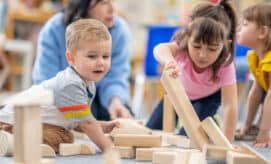When children and their families feel that they are valued members of an early care and learning community, meaningful relationships can be built that allow parents and educators to partner to support each child’s well-being. This collaborative relationship creates a safe environment in which children can learn, grow, and thrive.
As educators and caregivers, we can encourage family partnerships by communicating respect for each family’s lived experience and cultural context.
Conversations that Honor Family Experience
In their Position Statement on Advancing Equity, NAEYC explains that “families are the primary context for children’s development and learning. Family relationships precede and endure long after children’s relationships with early childhood educators have ended. Early childhood educators are responsible for partnering with families to ensure consistent relationships between school and home.”
Children are learning long before they enter our classrooms and programs. They come into our space with a wealth of knowledge and ideas about the way that the world around them works. In order for children to learn and thrive, they must know that we honor who they are when they come into our classroom. We can show children that we want to know who they are, by allowing them to teach us about what they already know. We can find joy, not only from teaching children, but by also allowing them to teach us.
We can connect with parents by telling them how much we enjoy their children, by sharing anecdotes about children’s classroom experiences, and by being interested in the stories they tell about their children’s experience.
Culture and Classroom Environment
One of the most important ways that we can help children feel welcome to participate in classroom activities is to offer a classroom environment and curriculum that represents their uniqueness and diversity. To create a caring, equitable community of engaged learners, NAEYC recommends that educators and caregivers “consider the developmental, cultural, and linguistic appropriateness of the learning environment and your teaching practices for each child…Children of all genders, with and without disabilities, should see themselves and their families, languages, and cultures regularly and meaningfully reflected in the environment and learning materials.”
Curriculum and instruction specialist Roisleen Todd notes that “students are more engaged academically and have improved social and emotional outcomes when they see and hear themselves reflected in the classroom environment and instruction…”
In an article written for Edutopia, Todd recommends a framework from educational researcher Geneva Gay’s book, Culturally Responsive Teaching: Theory, Research, and Practice, which highlights three questions that educators and caregivers can cask to create culturally relevant and empowering learning environments for students:
1. Who are our students?
Educators develop relationships with children and their families that allow them to learn about how their students are and then use this knowledge to ensure that the children’s voices and experiences are included in the classroom curriculum.
2. Who do our students see in our classrooms?
“The identities and the values attached to those identities within our classroom environment influence the ways in which our students develop their understandings about the world and about themselves”
3. How can educators move further toward Culturally Relevant Teaching (CRT)?
Once educators understand who is in their classroom, they can intentionally act to build a culturally relevant classroom, in which their students feel valued.
Additional Resources





